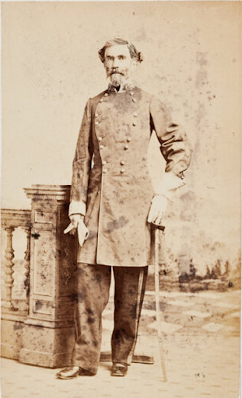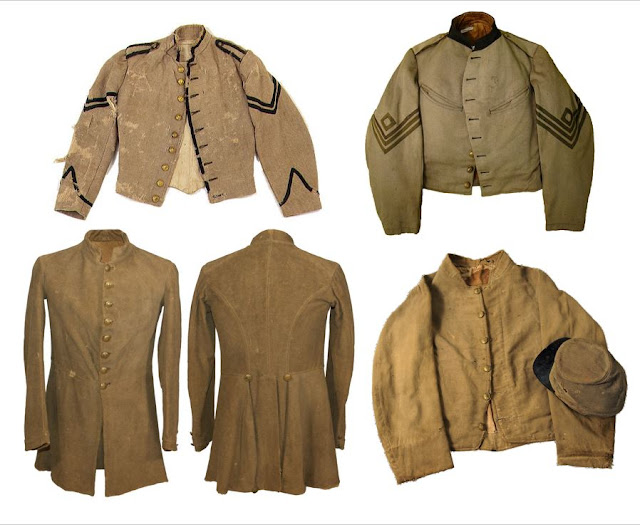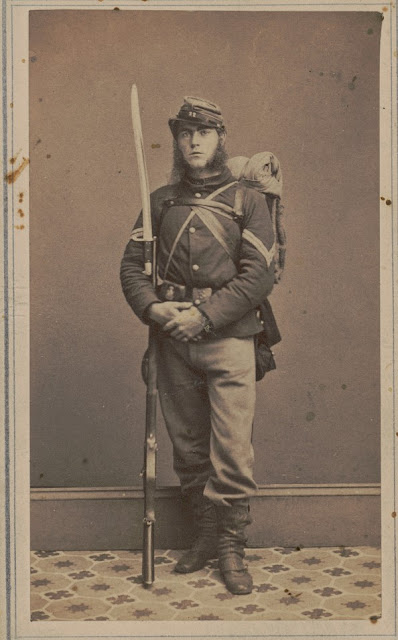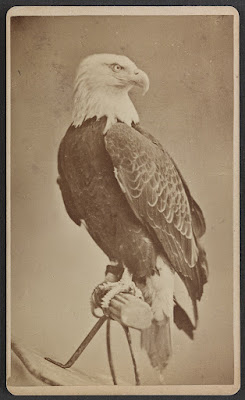Combat and Feral Hogs: A Georgian Remembers the Horrors of Stones River
For Corporal Walter B. Smith of the 3rd Georgia Infantry Battalion, the ending of the fighting at Stones River replaced the horrors of combat with a perhaps unexpected menace: a band of roving hogs.
His brigade had gone into bivouac in the cedar forest and as “the
fighting now ceased for the day on the part of our division we soon found
that we had a far different enemy to contend with- a drove of wild hogs had
commenced to devour the dead and wounded,” Smith recalled in 1902. “They seemed
perfectly crazed by the taste of human flesh. The writer saw several fighting
over the arms and entrails of the dead. The wounded and dead were soon gathered
up and it was necessary to put guards around them with fixed bayonets in order
to keep off the hogs.” Confederate burial details started work that night, in
part to get the bodies underground before the hogs could get at them as Smith
observed.
Corporal Smith’s gritty memoir of Stones River first saw publication in the June 15, 1902, edition of the Montgomery Advertiser.
The above-named battle was the first
conflict of any magnitude that the writer was engaged in. It proved to be a
terrific and bloody one and if you think it will interest your readers, you may
use it as you did my Missionary Ridge article.
The author, with his regiment, after
following General E. Kirby Smith into and out of Kentucky was hurried down to
Murfreesboro to participate in the big battle that was impending and which was
fought on the 31st day of December 1862. Our brigade, with the
exception of the 37th Georgia [which was formed as the consolidation
of the 3rd and 9th Georgia Battalions in the spring of
1863], was composed entirely of Tennesseans under the gallant young General Jim
Rains of Nashville, as brave a man as ever lived. Marcus Stovall, then our
colonel, commanded our battalion.
Our company was a mixture of town, country, and factory boys,
several of whom could not read or write and of course could not be expected to
know much about the outside world or how people thereof looked and dressed. But
they knew how to drill and fight. Out of five brothers on our company’s rolls,
only one could write and I believe at first they had the impression that the Yankees
were something on the order of wild animals, for in the opening of the
engagement I heard one exclaim, “I swear, they can shoot just like other folks!”
On the evening of the 30th we were thrown into
line to face some of the best soldiers the world has ever beheld. They were
western and northwestern men, some of whom were crack shots having handled guns
since boyhood. There was a vast difference in these troops and the Federals
soldiers of the east and north, for a great many of the latter had been brought
up in workshops, stores, and factories, had never handled firearms in all their
lives before they set out to conquer us. There were also among them a large
sprinkling of foreigners who did not care to sell their lives for the sake of
the Union, but not so the western and northwestern boys for they were “true blue”
and the old Confederates did not undervalue them. They knew that it was like
Greek meet Greek. The generals also realized this fact for both sides played
for advantage and it was by gaining the advantage that we won this fight.
Rosecrans had formed his army in front of Murfreesboro with
the mass of his troops on his left with the intention of forcing Stones River
on the north of the railroad. His right was more extended, forming something of
an angle with his center and left facing almost east. The river and Nashville
turnpike divided his army making nearly two separate wings. Our corps [Hardee’s],
composed of the divisions of Breckinridge, Cleburne, and McCown, formed the
left of Bragg’s army and were posted on the east bank of the river, extending
nearly to the Nashville road. Our army was estimated at about 40,000 effective
men. It was the intention of the Federal general to “lick” us on the morning of
the 31st but it was here that he got badly left.
Our brigade on the evening of the 29th was posted
near the extreme left but through a mistake was posted in such a manner as to
enable the enemy’s batteries to rake us from right to left. General Bragg, on
discovering our peril, rode up with his entire staff and demanded of General
Rains, “Who placed you here?” General Rains replied, “By order of General
McCown.” General Bragg’s next order was “change it sir, so your men cannot be
enfiladed,” or words to that effect. It was here that Bragg came near losing
his life for the enemy, surmising that it was some general of note with so
large a bodyguard opened fire with shrapnel and canister from a distance of not
700 yards. The writer was sitting within 10 feet of General Bragg and while
Bragg instinctively dodged from the shower of iron and balls that went hurtling
by Rains never moved a muscle of his face. Bragg, with his staff following him,
then galloped off to a heavy piece of woods in the edge of the field. It was
then nearly sundown. General Rains changed our position so that we fronted the
enemy which made us feel much easier.
At daylight on the morning of the 31st, we were
ordered to climb over the rail fence behind which we had hidden and go in a run
upon the enemy’s line, not to give them a chance or time to halt or form, and
not to sound the old Rebel yell until we were right upon them. General Rains,
on a powerful, large, black horse with our regimental colors in one hand, led
the way on a gallop, not even stopping at fences, his horse jumping them while
we just fell over them in a manner. So fast did we got that we were almost upon
the Federal pickets in the cornfield before they realized the fact and by the
time they had reached their main line, we were almost upon it.
Then, raising a terrific yell, we dashed among them, firing
right and left. The enemy was so completely taken by surprise that they made
but a feeble resistance. Those that were not shot down made a wild rush for the
rear, leaving their breakfasts and everything else, the Confederates in full
chase and yelling for all they were worth. Through cornfields, over fences,
past barns and dwellings we sped, scooping in the boys in blue by the hundreds
with now and then some very funny things happening to make us enjoy the chase.
It was on this run that the writer saw one very young Confederate order an old
Federal to “come out from behind that tree” and when he stepped out and
surrendered, we were surprised and amused to hear this young soldier exclaim, “Hello
dad! What in thunder are you doing with them that clothes one?” He had captured
his own father!
Another amusing scene occurred at a barn filled with hay in
which some Federals attempted to hide. On our surrounding it, several of the
enemy called out that they would surrender, and coming out gave themselves up.
One of our company, however, not being satisfied with the looks of things,
grabbed a pitchfork and went to probing in the hay. After several thrusts we
were startled and convulsed with laughter by hearing a Dutchman yell out, “Hould
up! Hould up! Mine Gott! I vill give up!” The hay tossed right and left and out
rolled the most badly frightened Dutchman I ever saw.
The enemy now threw forward a small body of cavalry to try
and check us but the open field affording an unobstructed view for a long
distance, they were seen in time to give us a chance to rally on our colors. We
then made a rush at their cavalry who put the spurs to their horses and went
racing after their infantry. We kept up the pursuit for about two miles,
forcing their right wing back in such a manner as to almost double it on their
left. Reaching a heavy piece of fenced woodland and backed by a dense cedar
thicket and being nearly out of ammunition, we threw forward a line of
skirmishers as a precaution against ambush.
It was fortunate that we did so for soon rapid firing in
front told us that the enemy had rushed reinforcements to try and stem the tide
of defeat and that our skirmishers were hotly engaged. Now the command “forward”
ran along the line and the boys almost at a double quick moved toward the
firing in front. Soon our skirmishers were seen falling back and then every man
seemed to know what was coming and nerved himself for it. Boom, boom, boom,
shh, shh, shh, bang, bang, bang! The enemy opened on us with several batteries.
But steadily we moved forward until we reached the brow of a small ravine or
large gully, backed by a dense cedar thicket where, crouched or kneeling not 50
steps below us with their guns at a ready was a heavy line of bluecoats. Such a
crash of musketry greeted us almost point-blank that it seemed as it no one
could escape. But our nearness and being above them was what saved us- their
shots passed above us.
The enemy doubtless thought they had wiped us off the face of
the earth but imagine their surprise when with a mighty Rebel yell we dashed
right into their very ranks with our guns loaded and began dealing death muzzle
to muzzle. The little gully was soon strewn with dead and dying and it was here
that our brave young General Rains fell, pierced through the heart while the
enemy’s colonel commanding their brigade Colonel Forman of Kentucky also fell,
pierced by three balls. [Colonel Forman led the 15th Kentucky, a
regiment a Colonel John Beatty’s brigade. His body was retrieved by his own
troops later that evening. See “Swallowed by the Cedars: A Day with the 15th
Kentucky”]
The death of our beloved general seemed to
rouse the demon of battle in every man and so fiercely did we fight that the enemy
again broke in wild disorder for the cedar thicket in their rear- our brigade
in full chase. It was here that I saw one of our boys stick his gun right
against a big Dutchman who was in the act of jumping over a pile a dead brush
and at the crack of the rifle, the Dutchman nearly tumbled a complete
somersault, falling into a small lime pit perfectly dead, his clothes smoking
from the fire from the rifle. The ball must have cut his heart in twain.
Again, the enemy threw forward a heavy
column and the fighting that followed was something on the Indian order. Our
ammunition having given out completely, Colonel Stovall, now commanding the
brigade, ordered us to rally on the colors. We then marched out of the cedar
thicket and took up a position on the brow of the very gully from which we had
been fired upon a short time before. The enemy, discovering or guessing the
cause of our falling back without replying to their shots, formed in heavy
column and began to move upon us.
Colonel Stovall, seeing the necessity
of holding our ground, rode up to the colors and gave in a voice like a trumpet
the command, “Fix bayonets! Boys, we will try cold steel on them.” It was then,
the writer must acknowledge, he felt the need of help and a great deal of help.
The enemy must have heard the command, for they halted and we were not sorry
that they did. It was now that we heard a heavy tramping in our rear and
looking back beheld a long line of Confederates headed by “Fighting Frank
Cheatham” as he was known in the army.
On opening our ranks to let them pass, one of Cheatham’s men
remarked, “Let us at them, we’ll give them hell!” I believe that all our boys
were perfectly willing to “let them at them.” In two or three minutes, they
reached the enemy who had again fallen back to the thicket and from the roar of
the rifles we knew that they were trying to keep their promise. The noise was
like that of a thousand packs of heavy firecrackers turned loose at the same
time. Soon our ears were greeted by the old familiar Rebel yell and we knew
that the enemy was in full flight.
 |
| Based on Corporal Smith's recollection, hogs roaming through the cedar forest started to consume the multitudes of dead soldiers while the smoke of battle still hung heavy among the trees. |
The fighting now ceased for the day on the part of our
division but we soon found that we had a far different enemy to contend with- a
drove of wild hogs had commenced to devour the dead and wounded. They seemed
perfectly crazed by the taste of human flesh. The writer saw several fighting
over the arms and entrails of the dead. The wounded and dead were soon gathered
up and it was necessary to put guards around them with fixed bayonets in order
to keep off the hogs.
The next day, General Bragg, believing we had gained a great victory and that the enemy was retreating, but he was partly mistaken. We had gained a great victory and one to be proud of but the enemy had only fallen back in order to straighten out his line and to be in a better position. On the 2nd of January a part of his army crossed the river and taking position opened up a heavy enfilading cannonade against General Polk’s command. General Breckinridge, with his division, drove the enemy back over the river but encountering heavy odds was in turn driven back with considerable loss. Both armies now rested, each watching the other. On the night of the 3rd, after having skirmished and fought for five days in the rain and cold, the enemy received heavy reinforcements and General Bragg retreated to Tullahoma. So ended the first Battle of Murfreesboro.
To learn more about the Stones River campaign, please click on the link below to visit the Battle of Stones River page which includes links to all of the 100+ posts I've written about Stones River.
And be sure to pick your copy of my award-winning campaign study Hell by the Acre available through Savas Beatie!
Source:
“An
Interesting Sketch of the First Battle of Murfreesboro, Tenn.” Corporal Walter
B. Smith, Co. F, 3rd Georgia Infantry Battalion, Montgomery
Advertiser (Alabama), June 15, 1902, pg. 5















Comments
Post a Comment